Search the Special Collections and Archives Portal
Search Results
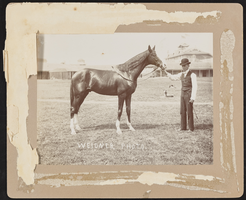
Photograph of a horse belonging to Evelyn Stewart
Date
1869 (year uncertain) to 1930 (year uncertain)
Archival Collection
Description
Weidner Photo is written on the photo.
Image
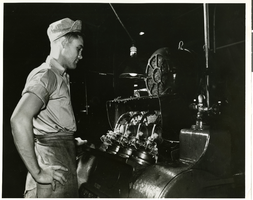
Photograph of a man working on rock bit drilling pieces at the Hughes Tool Co., Houston, Texas, circa 1950s
Date
1950 to 1959
Archival Collection
Description
Transcribed from attached press release: "HUGHES ROCK BIT PRODUCTION more than 500,000 rock bits produced last year by the Hughes Tool Company, Houston, Texas, for drilling the kind of deep wells which now produce 90 per cent of the world's petroleum. The rock bit was invented by Howard Hughes' father and the resulting business became the cornerstone on which Howard Hughes built his industrial empire. The machinist above is performing an operation on the cones which make up the rotating end of the Hughes rock bit." Transcribed from photo sleeve: "The Kearney and Trecker 4 spindle machine at the Hughes Tool Company in Houston, Texas. Ca. 1950s."
Image
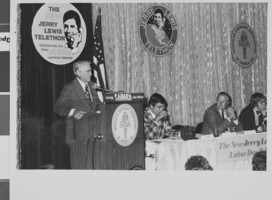
Photograph of Mayor Oran K, Gragson speaking at the pre-telethon production meeting, Las Vegas, Nevada, 1974
Date
1974
Archival Collection
Description
Las Vegas Mayor Oran K. Gragson (at the podium) addressing the general session at the pre-telethon production meeting for the Jerry Lewis Muscular Dystrophy Telethon at the Sahara Hotel and Casino. Oran Kenneth Gragson (February 14, 1911 – October 7, 2002) was an American businessman and politician. He was the longest-serving mayor of Las Vegas, Nevada, from 1959 to 1975. Gragson, a member of the Republican Party, was a small business owner who was elected Mayor on a reform platform against police corruption and for equal opportunity for people of all socio-economic and racial categories. Gragson died in a Las Vegas hospice on October 7, 2002, at the age of 91. The Oran K. Gragson Elementary School located at 555 N. Honolulu Street, Las Vegas, NV 89110 was named in his honor. The Jerry Lewis MDA Labor Day Telethon was an annual telethon held each Labor Day in the United States to raise money for the Muscular Dystrophy Association (MDA). The show was founded and hosted by actor and comedian Jerry Lewis, who hosted the broadcast from its 1966 inception until 2010. The history of MDA's telethon dated back to the 1950s, when the Jerry Lewis Thanksgiving Party for MDA raised funds for the organization's New York City area operations. The telethon was held annually on Labor Day weekend beginning in 1966, and would raise $2.45 billion for MDA from its inception through 2009. The telethon aired up to 21½ hours, starting on the Sunday evening preceding Labor Day and continuing until late Monday afternoon on the holiday itself. MDA called its network of participating stations the "Love Network". The show originated from Las Vegas for 28 of the years it was broadcast. Beginning in 2011, coinciding with Lewis's controversial departure, MDA radically reformatted and shortened the telethon's format into that of a benefit concert, shortening the length of the special each successive year. Successive telethons from 2012 to 2014 renamed the show as the MDA Show of Strength and further cut its airtime. The 2012 edition was reduced to three hours as a primetime-only broadcast. The 2012 edition did not refer itself as a "telethon". The 2013 Show of Strength discontinued the long-standing format of being syndicated to individual stations of varying network affiliation and aired on a major national network instead of being syndicated to individual stations, airing on ABC on Sunday, September 1, 2013, and being reduced to two hours. While the 2012 edition did not refer itself as a "telethon", it referred itself as such for the 2013 edition. The final edition, for 2014, aired on ABC on August 31, again as a two-hour special beginning at 9PM ET/PT. This was the final edition for the telethon, as it was announced on May 1, 2015 that the MDA would be discontinuing the annual event.
Image
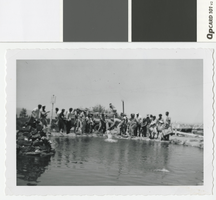
Photograph of a group of men releasing live rainbow trout into a pond, late 1950s
Date
Unknown year in the decade of the 1950s (year approximate)
Archival Collection
Description
Rainbow trout being released into a pond
Transcribed Notes: Transcribed from back of photo: "Dad & [Harold] unloading trout"
Image
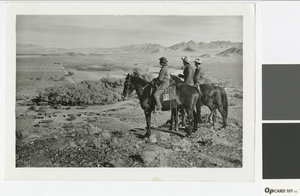
Photograph of Indian Springs from the hill behind it
Date
1900 (year approximate) to 1940 (year approximate)
Archival Collection
Description
Three men on horses looking over Indian Springs
Image
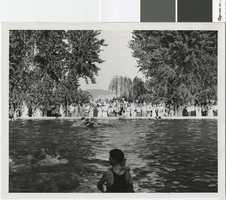
Photograph of swimming pool at Ladd's Resort, Las Vegas, 1920s-1930s
Date
1920 (year approximate) to 1930 (year approximate)
Archival Collection
Description
The swimming pool at Ladd's Resort in Las Vegas.
Image
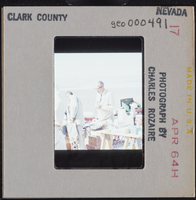
Photographic slide of men in Clark County, Nevada, circa 1963-1964
Date
1963 (year approximate) to 1964 (year approximate)
Archival Collection
Description
Unidentified men at an archaeological site.
Image
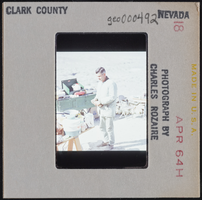
Photographic slide of a man in Clark County, Nevada, circa 1963-1964
Date
1963 (year approximate) to 1964 (year approximate)
Archival Collection
Description
An unidentified man at a Clark County, Nevada archaeological site.
Image
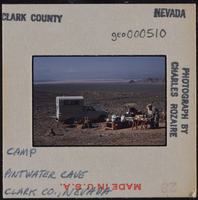
Photographic slide of desert campsite, Nevada, circa 1964-1965
Date
1964 (year approximate) to 1965 (year approximate)
Archival Collection
Description
An unidentified man at a campsite in the desert. Written on the slide: "Camp. Pintwater cave. Clark Co., Nevada."
Image
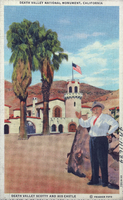
Postcard showing Scotty's Castle and Death Valley Scotty, Death Valley, California, circa 1930s
Date
1930 to 1939
Archival Collection
Description
A colored postcard showing an artist's representation of Scotty's Castle, Death Valley Scotty, and a stone covered in petroglyphs in Death Valley, California. Located within the far northern region of Death Valley in Grapevine Canyon, the Death Valley Ranch, more commonly known as Scotty's Castle, is a prime example of Spanish-Mediterranean styling during the Roaring '20s and Depression '30s. Death Valley Scotty, 1872-1954, was a prospector, performer, and con man whose was made famous by his scams involving gold mining near Death Valley. The petroglyph-covered rock beside Death Valley Scotty was designed by Native Americans who inhabited the valley hundreds of years ago. Transcribed across the borders of the image: "Death Valley National Monument, California; Death Valley Scotty And His Castle." The "Frasher's Foto" logo is branded upon the bottom right corner of the postcard.
Image
Pagination
Refine my results
Content Type
Creator or Contributor
Subject
Archival Collection
Digital Project
Resource Type
Material Type
Place
Language
